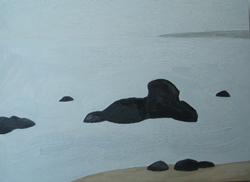

 Yuko Murata paints desolate landscapes featuring rocky crags and bare trees, or animals and birds placed within those sceneries. Using the restrained color palette of whites, blacks and washed-out blues, Murata gives these paintings on wooden panel the impression of being almost monochromatic, yet her bold and distinct brushstrokes hold sway over the surface of the works. She has recently taken up Japanese painting in the traditional medium of sumi (black ink) and has been fascinated with works especially by painters in the Edo period of the 18th-century. Through the choice of leaving portions of the panel blank and her preference for austere subject matter like barren landscapes, Murata’s paintings share an aesthetic and emotional connection with historic forms of Japanese artistic expression.
Yuko Murata paints desolate landscapes featuring rocky crags and bare trees, or animals and birds placed within those sceneries. Using the restrained color palette of whites, blacks and washed-out blues, Murata gives these paintings on wooden panel the impression of being almost monochromatic, yet her bold and distinct brushstrokes hold sway over the surface of the works. She has recently taken up Japanese painting in the traditional medium of sumi (black ink) and has been fascinated with works especially by painters in the Edo period of the 18th-century. Through the choice of leaving portions of the panel blank and her preference for austere subject matter like barren landscapes, Murata’s paintings share an aesthetic and emotional connection with historic forms of Japanese artistic expression.
In this age of reproduction, Murata, like many other contemporary artists working today, bases her paintings on photographs culled from various printed materials. These photographs, which originally appeared in travel books, pamphlets or illustrated encyclopedias, are a form of inviting visual information on fascinating unexplored places and animals all over the globe that are not often seen firsthand. Murata uses these photographs of idealized landscapes as a source of inspiration, simplifies the motifs she finds within them, and translates them into her unique visual language to construct her own imaginary world.
Murata’s paintings, which exclude human figures, make the viewer feel a certain sense of rigorousness. Yet, thanks to a tinge of a rounded edge and the flattened and softened forms of the painted motif, she captures landscapes and animals as adorable subjects that inhabit her personal sphere.